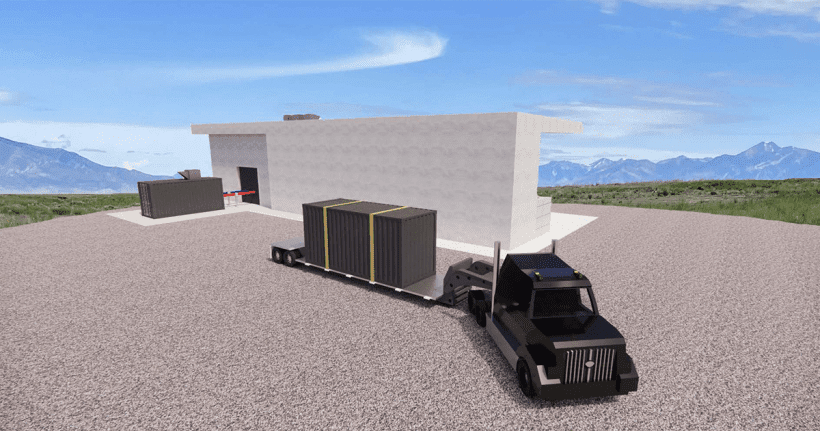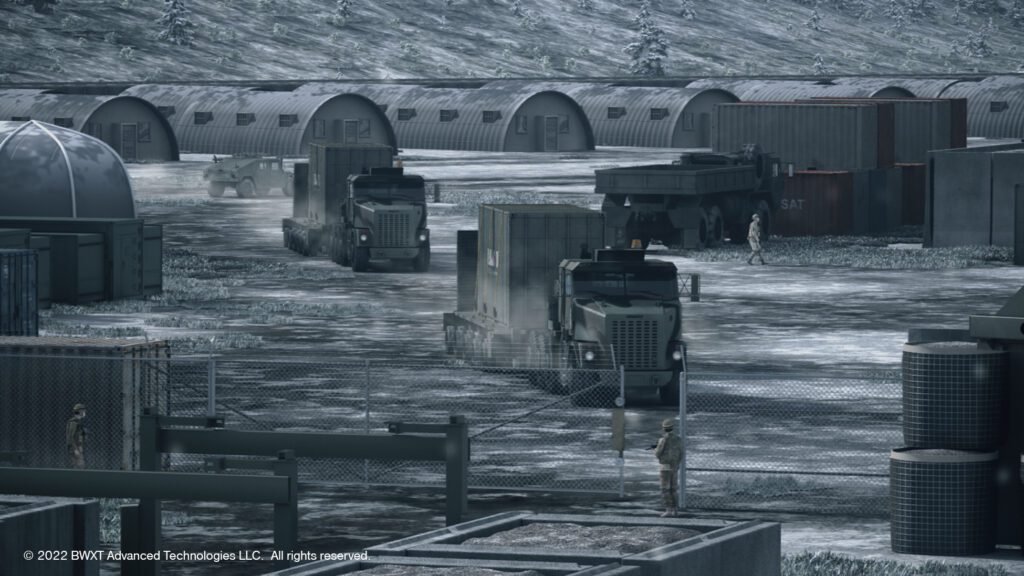Project Pele, DOD’s HTGR Mobile Nuclear Microreactor, Breaks Ground
Groundbreaking has kicked off at Idaho National Laboratory (INL), where Project Pele—the Department of Defense’s (DOD’s) full-scale transportable microreactor prototype—will be placed for testing in 2026. When operational, the reactor will become the “first-ever Generation IV nuclear reactor to generate electricity in the U.S.,” the DOD said on Sept. 24.
Project Pele, developed under a DOD Strategic Capabilities Office (SCO) initiative, aims to build and demonstrate a high-temperature gas-cooled (HTGR) mobile microreactor manufactured by Lynchburg, Virginia–headquartered BWXT Advanced Technologies. Fueled with TRI-structural ISOtropic particle fuel, Project Pele will produce 1 MWe to 5 MWe for INL’s Critical Infrastructure Test Range Complex (CITRC) electrical test grid for about three years.
“Assembly of the final reactor is set to begin in February 2025,” the DOD noted on Tuesday. “The current schedule includes transport of the fully-assembled reactor to INL in 2026.”

A Strategic Microreactor Deployment
Before testing, the microreactor will be fueled at INL’s Transient Reactor Test Facility, shipped to one of the CITRC pads, and assembled, tested, and operated. The reactor’s assembled configuration will include four 20-foot International Organization for Standardization (ISO) containers that resemble CONEX boxes (a large, metal weather-resistant container used to store or ship items) of about 8 feet wide, 8 feet high, and 20 feet long. Each container will contain one of Project Pele’s four modules: the reactor module, an intermediate heat exchange module, a control module, and a power conversion system module.
INL has already tested the custom-developed ISO containers and designed a planned shielding structure that will house three of the four containers. The Project Pele team is slated to build the concrete shield structure at the test site next year to be ready for reactor placement in 2026.
“Upon arriving at INL, the reactor will be transported by truck to the test site and positioned within the concrete shield structure. Piping and electrical wiring will tie the reactor to INL’s specialized electric microgrid,” the DOD said. “Once the reactor’s final safety review is completed, the Pele project team will then proceed with the initial Test and Evaluation plan.”
Given that the DOD and Department of Energy have agreed that Project Pele will be tested and operated under DOE authorization, Project Pele does not fall under the Nuclear Regulatory Commission’s (NRC) purview. However, the NRC has provided input through public meetings held with the Advisory Committee on Reactor Safeguards (ACRS) in late 2023 as part of developing a transportation framework for microreactors, a collaborative effort led by Pacific Northwest National Laboratory (PNNL) to enable future NRC approval for public road transport of microreactors beyond the INL site.
Groundbreaking Is a Major Milestone
Groundbreaking marks an essential phase of the much-watched program. The program launched in 2016 in response to a Defense Science Board study, which evaluated the DOD’s need for a mobile, reliable, and resilient power source that minimizes logistical demands. The study recognized that battlefield energy needs would dramatically increase with the rise of energy-intensive military systems. It identified nuclear power—which offers two million times the energy density of diesel—as an ideal solution.
Following a two-year reactor design competition that began in March 2020, the DOD formally released a record of decision to proceed with Project Pele in April 2022. The SCO considered two engineering designs selected as part of a preliminary design competition, which wrapped up in March 2021: an HTGR design from BWXT Advanced Technologies and X-energy’s Mobile Nuclear Power Plant. In June 2022, it picked BWX Technologies’ design for the microreactor, though in September 2023, it gave X-energy a one-year contract option to advance its design.
According to the DOE, Project Pele’s key objective is to demonstrate how transportable nuclear power “could meet the increasing demand for a resilient, carbon-free energy source capable of delivering reliable 24/7 power to mission-critical DoD operations in remote and austere environments.” However, while the demonstration is also seen as a potential “pathfinder” for future commercial applications of advanced reactors, no DOD plans exist for the Pele prototype reactor to move from the INL site.
“It has always been foreseeable that the next microreactor to follow the Pele prototype would be a different design. What is most important is creating a broad framework to allow any future commercial or military microreactor a clear pathway to regulatory approval,” wrote Dr. Jeff Waksman, Project Pele program manager to the NRC in April.
DOD Exploring Multiple Nuclear Power Initiatives
In April, during a U.S. Senate hearing, Secretary of the Army Christine Wormuth was asked whether the Army plans to transition Pele technology and its regulatory approach for operational or installation energy resiliency solutions. Wormuth said the Army is “interested” but suggested discussions were still in “early stages.”
“I think we will soon be entering into some discussions, some informational discussions with industry to learn more about what might be possible,” she said. “Because certainly, to the extent that we are able to have a reliable source of energy, if we have — you know, if the electric grid in many of our communities goes down for some reason, it certainly would be appealing to have something that is dependable and reliable.”
The U.S. Air Force, meanwhile, is separately exploring options for its first nuclear microreactor, which it plans planned for Eielson Air Force Base in Alaska in response to the Fiscal Year 2019 National Defense Authorization Act. The effort seeks to secure a power purchase agreement from a microreactor developer by the end of 2027. While the Air Force in August 2023 tentatively selected Oklo for the project in September 2023, it issued a Notice of Rescission “to give further consideration to the agency’s responsibilities” under the governmental acquisition rules. In May, the Air Force reported “procurement was placed on pause to allow for additional proposal review(s) set to be complete by the end of Summer 2024.”
“This program is a critical pathfinder to gather lessons learned for future innovative advanced nuclear projects to increase installation resilience,” it said. “It is imperative we adhere to acquisition protocols to ensure pilot success.”
The DOD is reportedly exploring several more initiatives. Hill Air Force Base is assessing how advanced nuclear power and thermal generation could enhance installation resilience through simulations conducted with Radiant under a Small Business Innovation Research award. Joint Base San Antonio (JBSA), in collaboration with local utilities, is exploring carbon-free energy solutions such as hydrogen, geothermal, and new nuclear technologies as part of a February 2024 memorandum of understanding. In parallel, the Defense Advanced Research Projects Agency (DARPA) and NASA are working on the DRACO program, which seeks to launch the first in-orbit demonstration of a nuclear thermal rocket by 2027.
Project Pele: A Potential ‘Pathfinder’
For the SCO, an agency established in 2012 to address emerging military challenges, accelerate the deployment of innovative solutions, and maintain the U.S. military’s technological advantage, Project Pele remains a flagship effort. SCO on Tuesday noted Project Pele is “a whole-of-government effort, with significant contributions from the Department of Energy, the National Nuclear Security Administration, and the Nuclear Regulatory Commission. The contractor team, led by BWXT Advanced Technologies, also includes critical roles played by Northrop Grumman, Rolls Royce Liberty Works, and Torch Technologies,” it said.
“The DoD has a long record of driving American innovation on strategic and critical technology,” said Jay Dryer, SCO director. “Project Pele is a key initiative for improving DoD energy resilience and will also play a crucial role in advancing nuclear power technology for civilian applications.”

BWXT, meanwhile, is already leveraging its work on Project Pele to advance the development of its civil-focused BANR microreactor, which is supported by the Department of Energy’s (DOE) Advanced Reactor Demonstration Program (ARDP). As POWER has recently reported, BWXT is now working with the Wyoming Energy Authority (WEA) to assess the viability of deploying small-scale nuclear reactors in the state. The collaboration includes a two-phase, $20.5 million project aimed at providing resilient energy for industries such as trona mining. BWXT is also exploring the potential for a TRISO fuel fabrication facility in Wyoming.
As envisioned by BWXT, BANR will be a “modular, factory-fabricated system that is small and light enough to be transported via rail, ship or truck.” The 50-MWth reactor will be scalable to site needs, utilize flexible power conversion to produce heat and power, and use high-density TRISO fuel particles.
—Sonal Patel is a POWER senior editor (@sonalcpatel, @POWERmagazine).